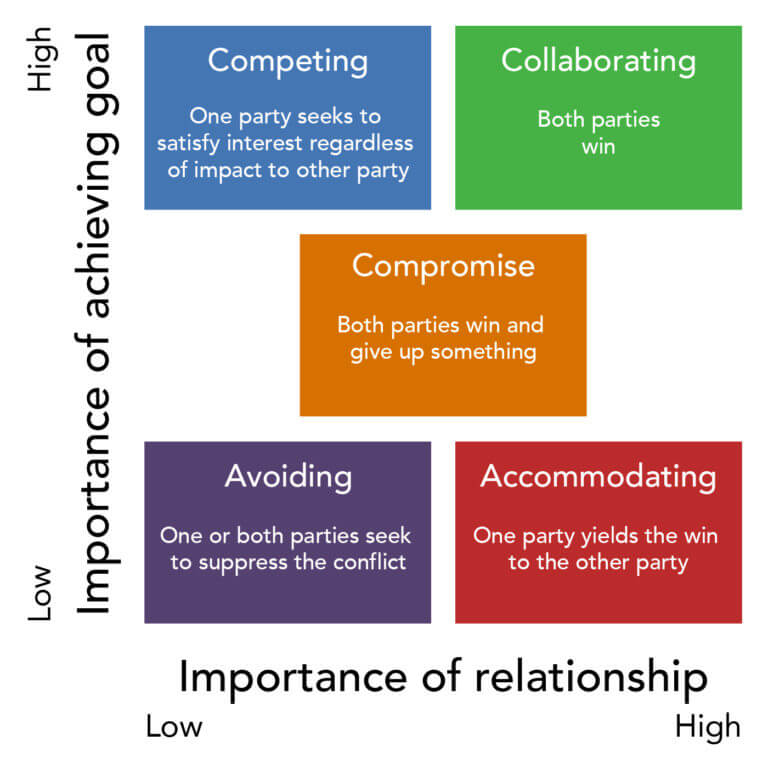Conflict management and resolution are critical in any organization. Every workplace hires people with different personalities, backgrounds, work styles, and values. It would be naïve to think that coworkers would never disagree on anything. Differences of opinion or clashes steaming from stress are common to every working environment, no matter how cohesive a team is. For this reason, when we recruit job candidates or develop employee growth programs, we evaluate conflict resolution skills. Today, we will focus on the most common conflict management styles all HR specialists should know and consider to increase teamwork, productivity, and personnel development in the organization.
What Are Conflict Management Styles?
When we discuss different styles of conflict management, we consider the diverse ways in which individuals address, engage in, and solve disputes at any level of the conflict’s stage. At this point, we consider it crucial to make a clear distinction between conflict management styles and the conflict resolution skills we discussed last time.
For instance, an employee can use assertiveness and creative problem-solving skills to approach a conflict from a collaborating perspective. In other words, conflict resolution strategies encompass plenty of the skills we already mentioned, together with personality traits, attitudes, and leadership skills, among others.
5 Conflict Management Styles to Observe and Understand in Any Organization
Human resources specialists worldwide use the Thomas-Kilmann Conflict Mode Instrument (TKI) to identify the major conflict management styles prevalent across all companies and organizations, big or small. According to this model, there are five styles of conflict management:
- Collaborating;
- Accommodating;
- Compromising;
- Avoiding;
- Competing.
According to the Thomas-Kilmann model of conflict management, people fall into two principal dimensions when choosing a conflict resolution strategy: assertiveness and cooperation. We have discussed assertiveness before as a communication skill and a conflict resolution skill, so you need to understand it in this model’s framework.
- Assertiveness in this context means focusing on your own needs and taking action to satisfy these needs in a conflict;
- Cooperativeness in this framework means valuing the relationship and taking action to satisfy the other’s needs.
The image below describes the five conflict management styles, in short, depending on how assertiveness and cooperation shift and intersect.
The Thomas-Kilmann Model of Conflict Management

Before we begin analyzing each of the five styles, we have to mention that each comes with its benefits and disadvantages. There is no perfectly right or wrong way to manage a conflict. Each of these styles has its time and place. According to Dr. Barbara Benoliel, Ph.D. in the Human and Social Services program at Walden University,
Understanding how you instinctively respond to conflicts and having increased awareness of other management styles may help how you typically approach specific situations and lead to efficient and effective conflict resolution.
The same goes for recruiters and HR specialists. Identifying these styles at the workplace allows companies to create better employee growth programs and conflict resolution skills training. Therefore, let’s discuss each of these styles to understand its pros, cons, and results without any more ado.
1. The Collaborating Conflict Management Style / I Win – You Win
The collaborating style of conflict management goes by the name of “win-win” because it leads to all parties achieving satisfaction at the conflict’s end.
- Assertiveness (Own Needs): High
- Collaboration (The Other’s Needs): High
- Conflict Resolution: I win, you win
This conflict management style is the most time-consuming and exhausting, although it generates the most sustainable and lengthy results.
In practice, it means that all parties involved in a conflict sit down, discuss the issues, negotiate, and actively explore paths to find a satisfactory solution together.
This conflict management style is desirable when the relationship between the parties is of utmost importance or when the solution found has a significant impact on the team and even the organization.
2. The Accommodating Conflict Management Style / I Lose – You Win
When someone yields and puts the other party’s needs before their own, it means you have an accommodating strategy of conflict resolution. It is successful in those situations where the conflict matter is less important than the relationship between the parties. Or when one party is not sure they are 100% right.
- Assertiveness (Own Needs): Low
- Collaboration (The Other’s Needs): High
- Conflict Resolution: I lose, you win
Knowing when to pick battles, keeping the peace, and not pressing on issues of low importance are the main traits of accommodators. At first glance, it might seem like one of the weakest conflict management strategies because the quarrel ends with a clear winner and a clear loser.
However, the accommodating style is successful when one party realizes that petty conflict topics can consume unnecessary resources. It is about seeing the bigger picture and prioritization.
Managers who choose the accommodating style for minor disagreements build a strong reputation with the team as being laid back enough to put conflicts to rest without grudges or reprisal. On the other hand, a leader who chooses this style to solve crucial problems will not solve anything in a meaningful way. On the contrary, they create a perception of weakness and indifference towards the big issues.
3. The Compromising Conflict Management Style / I Win Some – You Win Some
This conflict resolution strategy is probably the most prevalent across all organizations. It is about finding the middle ground. The parties involved in the conflict concede some parts of their needs/desires to reach a common satisfactory solution. It is not a perfect lose-lose situation, as there is a prize at the end of the conflict. However, when teams and managers repeatedly employ this strategy, the general feeling is losing, harboring frustration and unhappiness.
- Assertiveness (Own Needs): Medium
- Collaboration (The Other’s Needs): Medium
- Conflict Resolution: I win some, you win some.
This approach works best when a team needs to fix a problem and move the project forward quickly. It is more about solving a time crunch than finding the perfect answer to an issue. Used sparingly, this style sets the stage for better collaboration down the road. Employees see managers use this tactic as facilitators and mediators.
When this conflict solving strategy becomes the norm, feelings of resentment are unavoidable. If some conflict parties feel that they sacrificed too much, they might become unwilling to compromise again in the future.
4. The Avoiding Conflict Management Style / I Lose – You Lose
Avoiding conflicts at work and in our personal lives never leads to a constructive and satisfactory resolution of any problem. The avoidant conflict strategists display low levels of assertiveness and collaboration, making them unfit for leadership roles. We had mentioned diplomacy when we talked about finding managers or hiring employees with excellent interpersonal skills.
Among all conflict resolution strategies, the avoidant style is one of the least productive. Those who manage it can take different paths: ignore the conflict and walk away; remove one or more parties engaged in the conflict; reassign people to other projects/departments; pushing deadlines; put a halt on the entire project, etc.
- Assertiveness (Own Needs): Low
- Collaboration (The Other’s Needs): Low
- Conflict Resolution: I lose, you lose.
One of the few instances when this style yields positive results is when everybody involved needs to take some time and space off to cool down, reconsider, and come up with winning solutions to the problem. Other than that, avoiding conflicts can lead to disastrous results: the conflict escalates, resentment and anger plague the team, people resign, etc.
From an employee’s point of view, a manager who avoids conflicts seems incompetent to manage, handle disagreements and stress, or play the role of mediator and coach. When it comes to project management skills, team management is among the top abilities one should demonstrate via pre-employment assessments’ results, simulations, interviews, and daily practice.
5. The Competing Conflict Management Style / I Win – You Lose
The last entry on our list of conflict resolution strategies is the competing style, a perfect opposition to the compromising one. You can notice it in an organizational environment where one of the parties does not budge and does not collaborate. All they want is to be right and win the argument.
This style of conflict management almost makes assertiveness seem like a bad thing, which is not. When we see coworkers and managers who do not back down until they get their way, we tend to either fear their radicalism or praise their “vertical spines.”
- Assertiveness (Own Needs): High
- Collaboration (The Other’s Needs): Low
- Conflict Resolution: I win, you lose.
Like all of the four mentioned above, the competing style comes with its pros and cons. The positive side is that it generates good results when teams are under extreme pressure and no time for debates. Managers who won’t hear it any other way choose this style when they have to make unpopular decisions or when their morals/principles decide a specific course of action.
The negative side of this conflict resolution strategy is that the ones who abuse it become dictators in the eyes of their coworkers and employees. We love strong leaders. We tend to raise revolutions against totalitarian regimes.
As it is with authoritarian leadership, this conflict management style breeds resentment, frustration, even anger. Quashing any argument, debate, negotiation, collaboration, or compromise makes individuals unhappy and willing to find work elsewhere.
Why Do You Need to Observe and Assess Conflict Management Styles in the Organization?
The way people manage everyday conflicts at work speaks volumes about their abilities to become leaders someday. When you are developing employee growth programs, conflict resolution skills and strategies are excellent indicators that you have top talent on your hands that you need to reward.
As the assessment goes, you can start with behavioral interview questions in the pre-employment assessment stage. When you focus your talent acquisition strategies on finding future leaders in your organization, things will unfold naturally.
However, the best idea is to keep tabs on all the conflicts (small or big) occurring inside the company – as a responsible HR executive usually does. The people capable of using the right conflict management style in the right situation are assets you want to retain and reward.
Now, it is your time to share your thoughts and opinions! What are the most common conflict management styles in your organization? Which of the styles in the Thomas-Kilmann model do you find to be the most effective for your company?


